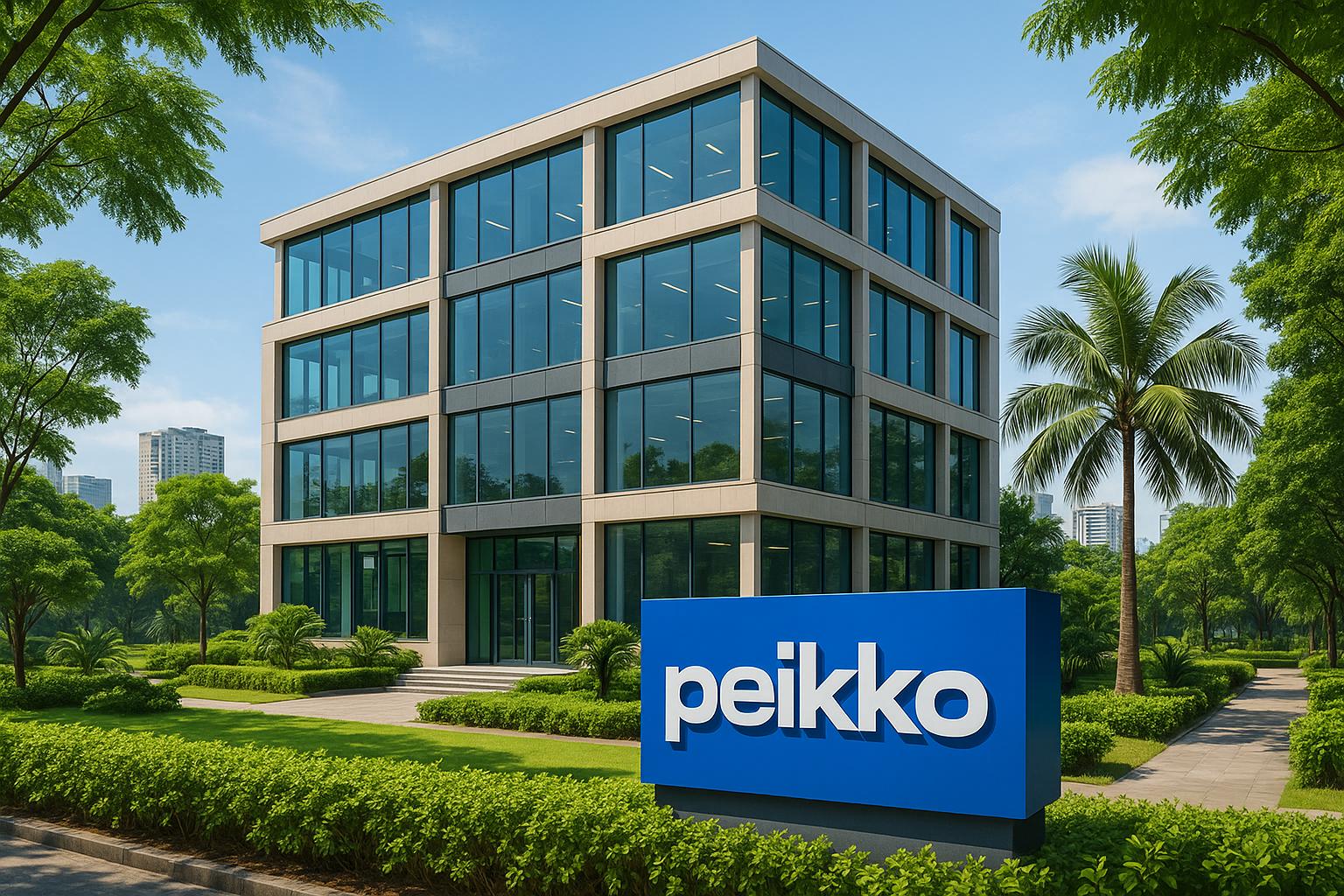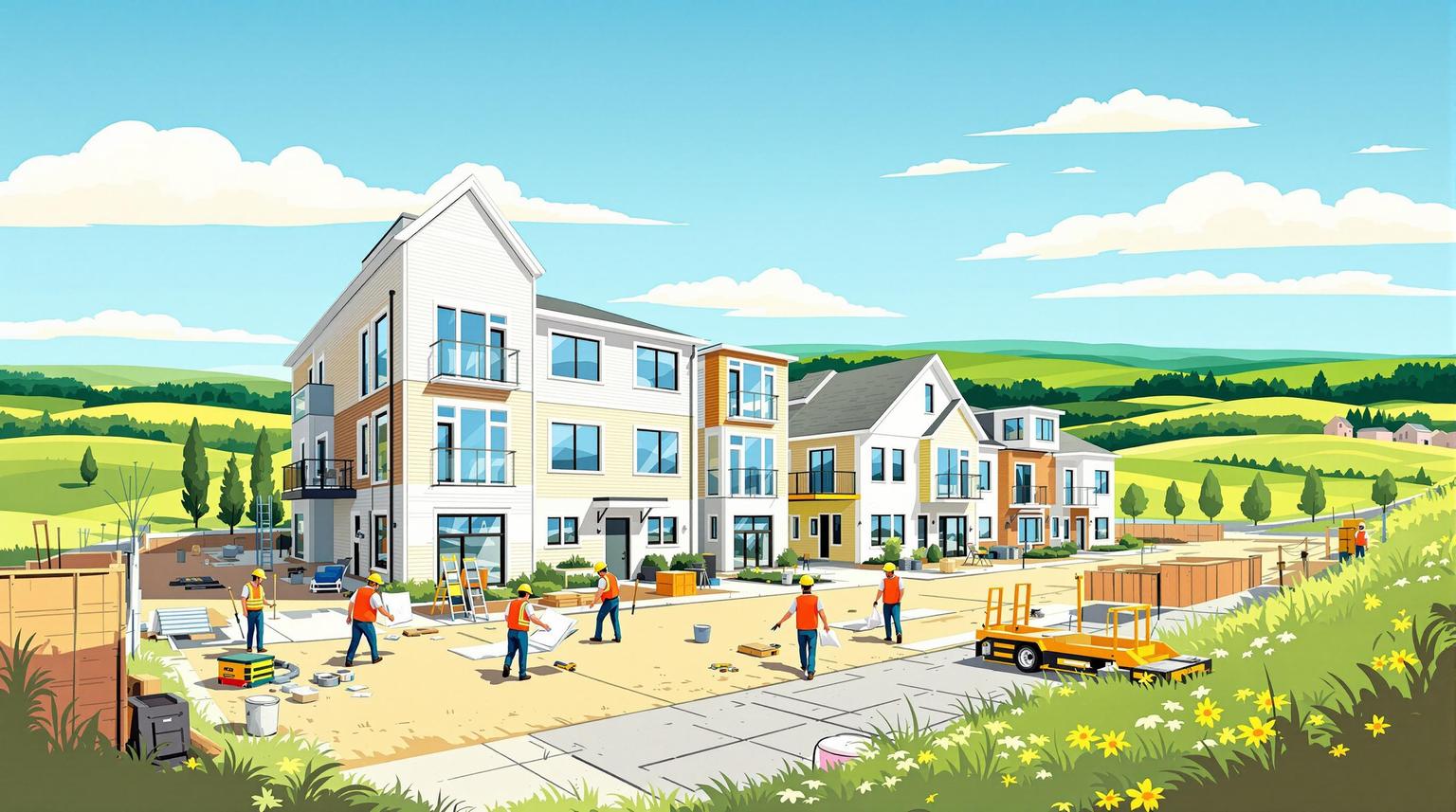In Nova Scotia, ER-2 zones strike a balance between preserving historic neighbourhood charm and allowing for modern multi-unit rental developments. These areas, found in places like Halifax's South End and downtown Dartmouth, permit 2–8 unit buildings (depending on lot size) while adhering to strict heritage design rules. Key guidelines ensure that new structures blend seamlessly with existing streetscapes, focusing on elements like window proportions, rooflines, and materials.
For property owners, success in ER-2 zones hinges on:
- Meeting heritage standards: Designs must pass the "glance test" to maintain the neighbourhood's character.
- Efficient construction: Using integrated teams prevents delays and budget overruns.
- Modern features: Energy-efficient systems, smart home tech, and updated interiors attract tenants willing to pay premium rents.
- Maximizing density: Conversions and rear additions can double rental income while staying compliant with zoning rules.
- Smart financing: Programs like CMHC MLI Select offer low down payments and extended amortisation terms to improve cash flow.
The right approach combines heritage compliance with modern amenities, creating rental properties that are both profitable and appealing to tenants.
Alex Bozikovic: Heritage Rules and the Housing Crisis
ER-2 Zoning Rules and Building Requirements
If you're considering multi-unit rental projects in ER-2 zones, it's essential to understand the zoning rules. ER-2 zones are designated as Established Residential areas, primarily meant for low-rise housing like single-family homes, duplexes, semi-detached dwellings, backyard suites, and secondary suites. When a property is located within or near a Heritage Conservation District or a designated Heritage Street, zoning rules are combined with heritage standards. Meeting these requirements is key to passing the 'glance test,' which ensures that new buildings blend seamlessly with the heritage streetscape. These rules create a framework that balances preserving historical charm with modern functionality.
Permitted Buildings and Density Limits
In ER-2 zones, low-rise residential buildings should align with the character of the surrounding neighbourhood. While a variety of housing types are allowed, the specific building forms and density limits depend on local municipal bylaws and any heritage designations. These regulations are in place to ensure that new developments remain consistent with the area's overall scale and aesthetic.
Heritage Design Requirements
For properties governed by heritage guidelines, additional design standards apply to preserve the historical character of the neighbourhood. These standards, outlined in conservation bylaws, focus on factors like scale and massing, ensuring new buildings complement existing heritage structures. It's a good idea to familiarize yourself with these guidelines early in the planning process to avoid design conflicts and ensure compliance.
Heritage Approval Process
Beyond adhering to design standards, the heritage approval process provides an added layer of oversight. Engaging with heritage planners early can help refine your design proposals and streamline the process. Applications are typically reviewed by a committee and may require adjustments before receiving final approval. Keep in mind that this process can take longer than standard residential permitting, so it's important to factor it into your project timeline to avoid delays.
Design Methods for ER-2 Multi-Unit Buildings
Designing multi-unit buildings in ER-2 heritage zones is all about finding the sweet spot between preserving historical character and meeting the practical needs of modern tenants. This delicate balance not only satisfies heritage review panels but also ensures the property appeals to today’s renters. Below, we explore specific methods for blending traditional and modern design elements.
Building Features That Combine Heritage and Modern Styles
Incorporating traditional architectural elements alongside modern functionality helps a building blend naturally into a heritage streetscape. Key features like gable roofs with subtle dormers, symmetrical tall and narrow windows, bay windows, and covered front porches reflect the local architectural style while maintaining a timeless charm.
Materials That Balance Heritage Standards and Durability
Using materials that honour heritage standards while offering long-lasting performance is essential. Traditional options like mud and limestone[1] uphold the cultural integrity of the design but can be costly to maintain. Modern alternatives, such as blended hydraulic cement and ready-mix concrete, provide durability and can mimic the appearance of traditional finishes. These materials strike a balance between aesthetics and practicality, making them ideal for multi-unit rental properties.
Modern construction techniques also support this integration. For example, concrete foundations and steel framing can be paired with traditional exterior finishes, ensuring the building’s structure is reliable without compromising its heritage appearance.
Modern Features That Preserve a Heritage Look
To modernize interiors while keeping the exterior true to its heritage, subtle yet effective updates can be made. Energy-efficient systems like advanced insulation, high-performance windows, and smart heating systems can be installed behind a traditional facade. Discreet ductless heat pumps deliver precise climate control without disrupting the building’s exterior design.
Inside, features like in-unit laundry, updated kitchens, and smart home technology enhance tenant comfort and convenience. Utility connections can be planned thoughtfully, with underground services and carefully hidden equipment to maintain the building’s traditional streetscape appeal while meeting modern infrastructure needs.
Single-Team Construction for ER-2 Projects
Building in ER-2 zones comes with its own set of challenges - mainly the need for coordinated expertise to prevent costly delays. When architects, engineers, and construction crews operate independently, the complexity skyrockets. This often leads to budget overruns and missed deadlines, jeopardizing your rental property investment. Let’s look at how a unified approach can sidestep these common pitfalls.
Problems with Multiple-Contractor Construction
The traditional method of hiring separate contractors for design, engineering, and construction creates a coordination nightmare, especially in heritage zones. Here’s why this approach can be problematic:
- Conflicting Designs: Separate teams often produce designs that clash, leading to expensive revisions.
- Budget Overruns: For example, an architect may complete drawings, but when the general contractor starts sourcing heritage-approved materials, costs can significantly exceed estimates.
- Timeline Delays: Miscommunication between teams can stretch an 8-month project to 18 months.
- No Unified Accountability: When problems arise, contractors may shift the blame to each other. This lack of accountability not only causes delays but also increases carrying costs as your property sits unfinished.
Benefits of Single-Team Design-Build
An integrated design-build approach tackles these issues head-on. Companies like Helio Urban Development streamline the entire process, ensuring fixed pricing and guaranteed timelines while aligning heritage design and construction needs.
- Fixed Pricing: With one team handling the entire project, costs are locked in. For instance, Helio offers a fixed price of $160,000 per unit, covering everything from design to construction. This approach has resulted in $0 budget overruns, as potential issues are addressed during the design phase.
- Guaranteed Timelines: Helio guarantees a 6-month construction timeline, backed by financial penalties of up to $1,000 per day for delays. This allows property owners to confidently plan for rental income without worrying about prolonged construction periods.
-
Single Point of Accountability: An integrated team eliminates the blame game. As Helio’s CEO Lloyd Liu puts it:
I personally guarantee every timeline because I've felt the pain of construction delays.
This commitment is supported by a system designed to prevent the coordination issues that typically cause delays.
Fragmented Teams vs. Integrated Teams
| Aspect | Fragmented Teams | Integrated Teams |
|---|---|---|
| Budget Control | Cost-plus contracts, often leading to 30–60% overruns | Fixed price of $160,000/unit with $0 overruns |
| Timeline Certainty | Projects often extend to 12–18 months | 6-month guarantee or $1,000/day penalty |
| Project Accountability | Multiple contractors, leading to finger-pointing | Single team responsible for the entire project |
| Heritage Coordination | Separate teams, prone to miscommunication | Consistent compliance with heritage requirements |
| Change Management | Expensive change orders from multiple parties | Changes managed within a fixed-price structure |
| Quality Control | Varying standards and warranties | Triple verification process with a 2-year warranty |
The advantages of an integrated approach go beyond just construction costs. By delivering projects in 6 months instead of the typical 12–18 months, Helio enables property owners to start collecting rental income - approximately $8,000 monthly for a standard fourplex - months earlier. This earlier cash flow can help offset the higher upfront investment in an integrated solution.
Additionally, Helio provides daily photo updates, giving you real-time progress without the hassle of chasing multiple contractors for updates.
sbb-itb-16b8a48
Making ER-2 Properties Profitable and Tenant-Friendly
To make heritage properties in ER-2 zones both profitable and appealing to tenants, a careful mix of preservation and smart investment is essential. Successfully balancing heritage requirements with modern profitability opens doors to strategies that enhance rental income while keeping tenants happy.
Increasing Unit Count Through Conversions and Additions
One effective way to boost rental income in ER-2 zones is by increasing the number of rental units without compromising the heritage character. This can be done through thoughtful interior conversions and rear additions that adhere to zoning regulations.
For instance, a heritage duplex can be transformed into a fourplex by reworking the floor plans and adding a second entrance - all while maintaining the original façade. Each additional unit, renting for $1,950 to $2,100 per month, can significantly increase your cash flow.
Rear additions also provide an opportunity to expand. Since ER-2 regulations typically focus on street-facing aspects, adding units at the back allows for modern design elements that meet height and setback rules. This approach is particularly effective for creating two-bedroom units, which tend to attract higher rents in Nova Scotia.
Take a duplex earning $3,900 monthly as an example. Converting it into a fourplex with nearly $8,000 in monthly rental income could cover construction costs in as little as 18 to 24 months.
Creating Spaces Tenants Want to Rent
Expanding units is just one part of the equation. To keep demand high, the design must also meet tenant expectations. Today’s renters value energy efficiency and convenience, so it’s crucial to incorporate features that reduce utility costs while respecting heritage aesthetics.
Energy-efficient upgrades, like ductless heat pumps for targeted heating and cooling or triple-pane windows to cut noise and energy bills, can make units more attractive. These updates not only lower operating costs but also appeal to eco-conscious tenants.
Smart design choices also play a role. Open-concept layouts can make spaces feel larger, while integrated storage solutions address the common storage constraints in heritage buildings. These details not only enhance tenant satisfaction but also justify higher rents.
Modern amenities are a must. Features like in-unit laundry, dishwashers, quartz countertops, and engineered hardwood floors can set your property apart in a competitive market. Additionally, smart home technologies - such as keyless entry, programmable thermostats, and doorbell cameras - offer convenience and security without altering the heritage exterior, making them a valuable addition.
Using Canadian Financing Programs for Better Cash Flow
The CMHC MLI Select program is a game-changer for financing ER-2 heritage properties. With 95% financing and a low 5% down payment, it offers a significant advantage over the standard 25% down required for rental properties.
The program’s 50-year amortisation term can dramatically improve monthly cash flow. For example, financing an $800,000 fourplex through MLI Select could result in positive cash flow from the start, compared to conventional loans that often require ongoing monthly contributions.
To qualify, properties must achieve a 40% improvement in energy efficiency over standard building codes. This typically involves upgrades like better insulation, high-efficiency heating systems, and improved building envelopes. While these upgrades can add about $200,000 per unit to construction costs, the financing benefits often outweigh the initial investment.
The leverage offered by MLI Select is another major advantage. With an effective leverage ratio of 20:1 compared to 5:1 for traditional financing, property owners can expand their portfolios more quickly, building more units with the same capital. This approach can yield annual returns ranging from 12% to 20% on ER-2 heritage properties.
Building Successful ER-2 Heritage Properties
Creating profitable ER-2 rental properties involves a careful balance of heritage preservation, modern functionality, and financial viability. These projects thrive when heritage requirements are seamlessly integrated with efficient construction methods and market demands.
The foundation of any successful ER-2 project lies in early, comprehensive planning. This includes assembling a team that understands both heritage approval processes and the needs of today's rental market. When design, engineering, and construction teams collaborate from the outset, costly revisions and delays - common in disjointed projects - are avoided.
Material selection plays a pivotal role in ensuring long-term success. Materials must align with heritage standards while also being durable and cost-effective. For example, triple-pane windows maintain a heritage-appropriate appearance while offering energy efficiency, which not only appeals to tenants but also lowers operating expenses.
ER-2 zoning allows for strategic conversions and additions that increase property density without sacrificing heritage character. This flexibility can significantly enhance the property's value and appeal.
Financing is another critical factor. While meeting energy efficiency requirements may increase initial construction costs, these investments are often offset by financing advantages and long-term savings. Optimized financing strategies help maintain strong cash flow, making the added expenses manageable.
An integrated design-build approach is essential for staying on schedule and within budget. This method avoids the delays and disputes that can arise when multiple contractors work independently - a frequent issue in the complex world of heritage projects.
The most lucrative ER-2 properties blend heritage compliance with modern amenities. Features like in-unit laundry, smart home technology, and energy-efficient heating systems attract high-quality tenants while maintaining the property's historical charm. These upgrades can justify rental rates between $1,950 and $2,100 per month, all while keeping operating costs under control.
Ultimately, success in ER-2 Heritage Streets is about systematic execution. Property owners who view heritage compliance, modern design, and financial performance as interconnected aspects - rather than separate challenges - consistently achieve impressive annual returns of 12% to 20%. This approach not only ensures profitability but also demonstrates how heritage development can meet the demands of modern living.
FAQs
What does the 'glance test' mean for ER-2 heritage zones, and why should property owners care?
The 'Glance Test': Why It Matters
The 'glance test' is all about the first impression a building gives and whether it fits naturally within the heritage character of ER-2 zones. It’s a quick visual check to see if the design aligns with local heritage guidelines while still being easy on the eyes.
For property owners, passing this test is more than just a formality - it’s essential. It helps protect the charm of the neighbourhood, ensures adherence to heritage rules, and can even make the property more attractive to tenants. A thoughtfully designed property doesn’t just preserve the area’s unique appeal; it can also lead to better rental opportunities and add to the property’s long-term value.
How can property owners in Nova Scotia's ER-2 zones preserve heritage charm while offering modern amenities to attract quality tenants?
Property owners in Nova Scotia's ER-2 zones have the opportunity to merge the timeless charm of heritage properties with the convenience of modern living. By integrating energy-efficient upgrades - like modern HVAC systems and LED lighting - alongside smart technologies such as programmable thermostats, they can create comfortable, eco-friendly spaces. Adding subtle safety features ensures tenant well-being without detracting from the building's historical character.
Emphasizing the building's unique charm and historical importance in marketing efforts can attract tenants who appreciate heritage aesthetics. This approach appeals especially to professionals and creatives seeking a balance between authenticity and modern amenities. By maintaining the property's architectural integrity while offering contemporary comforts, owners can meet heritage guidelines and attract high-quality tenants, all while ensuring profitability.
What are the advantages of using a design-build approach for projects in ER-2 heritage zones?
The Benefits of the Design-Build Approach in ER-2 Heritage Zones
The design-build method simplifies the process of managing projects in ER-2 heritage zones by combining design and construction under one unified team. This collaborative approach not only reduces the chances of miscommunication but also speeds up project timelines and ensures a higher level of accountability throughout.
One key advantage is the ability to manage costs early on, helping to keep budgets under control. Additionally, this method minimizes risks by integrating heritage preservation directly into the planning and execution phases. The result? A seamless blend of heritage requirements and modern functionality, delivering a final outcome that respects local heritage standards while meeting the needs of tenants and the broader community.



